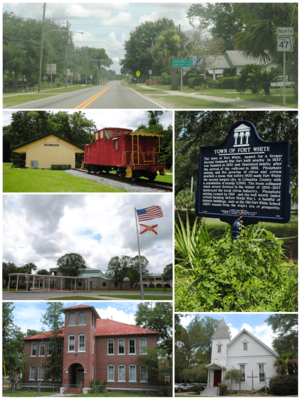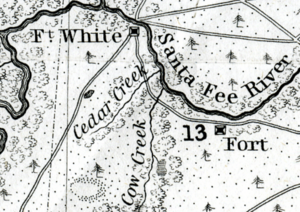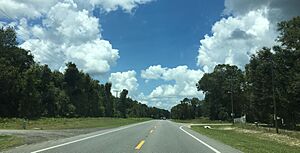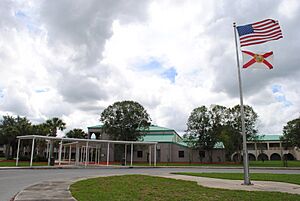Fort White, Florida facts for kids
Quick facts for kids
Fort White, Florida
|
|
|---|---|
| Town of Fort White | |

Top, left to right: Florida State Road 47 in Fort White, Fort White Train Depot, Fort White High School, Town of Fort White Historical Marker, Fort White Public School Historic District, Fort White United Methodist Church
|
|
| Motto(s):
"Home of the Ichetucknee River"
|
|

Location in Columbia County and the state of Florida
|
|
| Country | |
| State | |
| County | Columbia |
| Settled | 1836 |
| Incorporated | 1884 |
| Government | |
| • Type | Mayor-Council |
| Area | |
| • Total | 2.41 sq mi (6.25 km2) |
| • Land | 2.41 sq mi (6.25 km2) |
| • Water | 0.00 sq mi (0.00 km2) |
| Elevation | 69 ft (21 m) |
| Population
(2020)
|
|
| • Total | 618 |
| • Density | 256.01/sq mi (98.86/km2) |
| Time zone | UTC-5 (Eastern (EST)) |
| • Summer (DST) | UTC-4 (EDT) |
| ZIP code |
32038
|
| Area code(s) | 386 |
| FIPS code | 12-24500 |
| GNIS feature ID | 0282713 |
Fort White is a town in Columbia County, Florida, United States, named after a military fort built in the 1830s. It is the closest town to Ichetucknee Springs State Park. Fort White High School and the Fort White Public School Historic District are located within the town's borders. The original school building was constructed in 1915. As of the 2020 census, the population of Fort White was 618, up from 567 at the 2010 census. It is part of the Lake City, Florida Micropolitan Statistical Area.
Contents
History
Fort White was originally constructed as a military fort during the Second Seminole War in 1836 to protect the Cow Creek settlement. Supplies were brought in by steamboat on the Santa Fe River and distributed to other area forts. Due to sickness, flooding along the river and rumors of the railroad coming to the area, the settlement was moved 4 miles (6 km) east to its present location.
Named after the military fort, in 1884, the Town of Fort White was officially incorporated and grew steadily, following the arrival of the railroad in 1888. Phosphate mining, turpentine and agriculture (cotton and oranges) were the foundation of the economy, and the population grew to nearly 2,000. The boom turned to bust as severe freezes in the winters of 1896 and 1897 destroyed the local citrus industry. By 1910, the largest phosphate deposits were depleted and mining ceased. The boll weevil ended cotton farming before World War I, and the population shrank to a few hundred people, primarily farmers, ranchers and foresters. The town's population in 1979 was 365.
Geography
The approximate coordinates for the Town of Fort White is located in southern Columbia County at 29°55′23″N 82°42′51″W / 29.92306°N 82.71417°W (29.923001, –82.714299), at the intersection of U.S. Route 27 and Florida State Road 47. SR 47 leads north 20 miles (32 km) to Lake City, the Columbia County seat, and south 23 miles (37 km) to Trenton. US 27 leads southeast 16 miles (26 km) to Alachua and Interstate 75, and west 13 miles (21 km) to Branford.
According to the United States Census Bureau, Fort White has a total area of 2.4 square miles (6.2 km2), all land. Most of the land surrounding the town is family farms and/or forests.
The Ichetucknee River
The locals have always known of and enjoyed the crystal clear Ichetucknee River and springs, located 4 miles (6 km) northwest of the town. However, before 1970, the existence and location of this natural wonder were not widely known. The road to the spring was not paved, nor was it marked, because the spring was on private property. In 1970, the state of Florida purchased the Ichetucknee spring and river property from the Loncala Phosphate Corporation. Columbia County built a paved road, number 238, providing easier access to the springs. In 1972, the head spring of the river was declared a National Natural Landmark by the U.S. Department of the Interior. The main tributary from Ichetucknee Springs became one of the most popular tubing destinations in the world, attracting up to 5,000 visitors each day during the summer. Others came to the river to swim, picnic, snorkel, scuba dive, and explore the nearby forests.
Climate
The climate in this area is characterized by hot, humid summers and generally mild winters. According to the Köppen climate classification, the Town of Fort White has a humid subtropical climate zone (Cfa).
Demographics
| Historical population | |||
|---|---|---|---|
| Census | Pop. | %± | |
| 1890 | 376 | — | |
| 1900 | 600 | 59.6% | |
| 1910 | 329 | −45.2% | |
| 1920 | 360 | 9.4% | |
| 1930 | 272 | −24.4% | |
| 1940 | 317 | 16.5% | |
| 1950 | 329 | 3.8% | |
| 1960 | 425 | 29.2% | |
| 1970 | 365 | −14.1% | |
| 1980 | 386 | 5.8% | |
| 1990 | 268 | −30.6% | |
| 2000 | 409 | 52.6% | |
| 2010 | 567 | 38.6% | |
| 2020 | 618 | 9.0% | |
| U.S. Decennial Census | |||
2010 and 2020 census
| Race | Pop 2010 | Pop 2020 | % 2010 | % 2020 |
|---|---|---|---|---|
| White (NH) | 334 | 406 | 58.91% | 65.70% |
| Black or African American (NH) | 171 | 149 | 30.16% | 24.11% |
| Native American or Alaska Native (NH) | 4 | 2 | 0.71% | 0.32% |
| Asian (NH) | 3 | 5 | 0.53% | 0.81% |
| Pacific Islander or Native Hawaiian (NH) | 0 | 1 | 0.00% | 0.16% |
| Some other race (NH) | 1 | 2 | 0.18% | 0.32% |
| Two or more races/Multiracial (NH) | 12 | 12 | 2.12% | 1.94% |
| Hispanic or Latino (any race) | 42 | 41 | 7.41% | 6.63% |
| Total | 567 | 618 |
As of the 2020 United States census, there were 618 people, 214 households, and 164 families residing in the town.
As of the 2010 United States census, there were 567 people, 311 households, and 169 families residing in the town.
Schools
The public schools located within the Town of Fort White are served by the Columbia County School District.
- Fort White Elementary School
- Fort White Middle School
- Fort White High School
The original Fort White High School was constructed during 1915, and an auditorium was added in 1936. Separate elementary school classrooms were completed in 1938.
The last high school class to graduate was in 1969, about the same time desegregation and integration forced the closing of the black schools in the area. At that time, there weren't enough children to justify a high school in Fort White; students in grades 9–12 were bused 20 miles (32 km) to Columbia High School in Lake City for over 30 years. After Ichetucknee Springs State Park opened in 1971, the population in the south end of the county steadily grew to the point where the need for a local facility was substantiated.
A $25 million high school was completed in December 2000 for grades 6–12, having opened in August 2000, in temporary buildings because of construction delays. The school had been scheduled for completion in August 2000. Fort White High School graduated the first class in a generation in 2001. A new Fort White Middle School for grade 6 was completed prior to the 2008–2009 school year. The rest of the middle school (for grades 7 and 8) has recently been finished and is in use, though the middle and high school are still joined.
See also
 In Spanish: Fort White para niños
In Spanish: Fort White para niños




